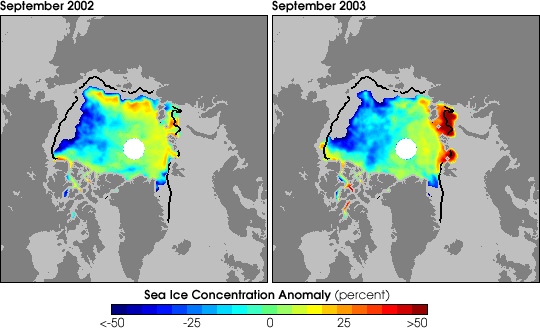

Ice at a Threshold? |
|||
Mark Serreze, a senior researcher at the National Snow and Ice Data Center, suspects that Arctic sea ice could be reaching a kind of turning point. Serreze was the lead author of last year’s paper that found the extent of Arctic sea ice had reached the lowest level in the satellite record in 2002. The study made use of NASA’s Moderate Resolution Imaging Spectroradiometer (MODIS) instrument on the Terra satellite. From preliminary results, Serreze says that Arctic sea ice conditions in 2003 rival those seen last year. |
|||
 |
“It appears that ice extent for September 2003 is the second lowest in the satellite record—2002 barely beat it,” Serreze says. “ In other words, we have not seen a recovery.” This year’s sea ice extent appears to be reinforcing a general downward trend, Serreze adds. |
The long-term trend in September sea-ice extent is in steady decline, with roughly 500,000 square kilometers of sea ice disappearing per decade. (Graph by Robert Simmon, based on data from Robert Gersten, SSAI and Josefino Comiso, NASA GSFC) | |
 | |||
Researchers at the University of Washington have shown that the decreasing sea ice trend is linked in part to a cyclical atmospheric pressure system, called the Arctic Oscillation. This oscillation refers to a pattern of low- and high-pressure systems between the Arctic and the mid-latitudes. When the oscillation is in its positive phase, as it has been generally over the last 20 years, air pressure tends to be low over the Arctic Ocean. This pattern pulls in warmer air from the surrounding area in a low-level counter-clockwise spiral and helps to break up the sea ice and blow it out of the Arctic. Serreze believes that the September 2002 low-ice mark was reached due to unusually warm temperatures and frequent storms that worked in tandem to break up and melt the ice. The Arctic oscillation was in a positive phase the previous winter and appears to have played a role. But the Arctic Oscillation doesn’t explain everything, and there are signs that it may be moving back to a more neutral phase. Whether this will be just a temporary shift is not known. Yet the ice continues to retreat. “The more recent years have shown indications of a recovery in the Arctic Oscillation towards more neutral conditions, but we’ve still seen decay in sea ice,” Serreze says. He wonders if the ice has thinned to a point where it has reached a threshold; a situation where thin ice and warming waters reinforce each other, regardless of pressure patterns like the Arctic Oscillation. |
In 2002 the extent of multi-year Arctic sea ice (colored regions) was the lowest recorded since satellite observations began in 1973, and there was only slightly more ice in 2003. The black line represents the average ice extent over a twenty-year period. (Maps courtesy National Snow and Ice Data Center) | ||